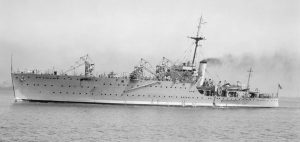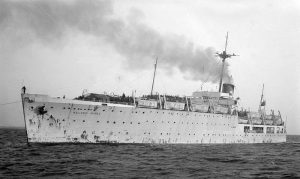- Author
- Haken, J.K., Dr
- Subjects
- Naval Aviation, Ship histories and stories
- Tags
-
- RAN Ships
- HMAS Albatross
- Publication
- December 2018 edition of the Naval Historical Review (all rights reserved)
The first HMAS Albatross was a locally built seaplane tender which had a short RAN career, saw wartime service as HMS Albatross, first as a seaplane tender then as a fleet repair vessel. Subsequently she became SS Hellenic Prince, a migrant ship which made several passages to Australia, then as a troopship, to Kenya.
Currently HMAS Albatross, previously Naval Air Station, Nowra, is the sole Australian Air Station, home to the Royal Australian Navy Fleet Air Arm and one of the largest Australian Naval shore establishments.
Schofields aerodrome to the west of Sydney was used by the RAAF and the Royal Naval Air Services during WWII and was temporarily commissioned as HMAS Albatross II. On 1 April 1953 Schofields was recommissioned as HMAS Nirimba,a technical training establishment for the RAN Fleet Air Arm. It was however short lived in this role and two years later became the overall RAN Apprentice Training Establishment.
Less well known is the previous HMAS Albatross, a seaplane tender which had a short RAN career. The vessel was built by Cockatoo Docks and Engineering Company Pty. Ltd. with the keel laid on 16 April 1926 and launched on 23 February 1928 by Lady Stonehaven, the wife of the Governor-General. Commissioned on 23 January 1929 and decommissioned on 26 April 1933. In service much time was spent in Sydney Harbour but cruises were made to other states and New Guinea. After decommissioning the ship remained in Sydney for five years. A crane was replaced during this period and readiness for service in seven days was maintained. In reserve the seaplanes were removed and the vessel was used as a base for visiting aircraft.
Specifications and details of the ship are shown in Table 1
| Displacement | 4354.49 tonnes |
| Length | 135.02 metres |
| Beam | 18.29 metres |
| Draught | 4.96 metres |
| Cruising Speed | 20 knots |
| Range | 7,930 kilometres at 22 knots, 14,600 kilometres at 10 knots |
| Engines | 4 Yarrow boilers. Parson Turbines 12,000 HP driving 2 propellers. |
| Armaments | Largest 4 x 120 mm guns |
| Complement | 450 including 32 members of the RAAF |
| Aircraft | 9 seaplanes |
Table 1
The ship was accepted by British Authorities as part payment for the light cruiser HMS Apollo, which had entered service in 1936 and was renamed HMAS Hobart III. HMAS Albatross was recommissioned and sailed for England 19 July 1938, reaching Plymouth on 9 September 1938.
The Commanding Officers of HMAS Albatross are shown in Table 2.
| Commanding Officer | Date of Command | Reference |
| Captain Denham Bedford RN | 23 January 1929 | 5 |
| Captain Henry Feakes RAN | 14 August 1930 | 6 |
| Captain Cuthbert Pope RAN | 3 August 1931 | 7 |
| Captain Harry Howden RAN | March 1933 | 8 |
| Captain Hubert Acland DSO, RN | 19 April 1938 | 9 |
Table 2
The ship was renamed HMS Albatross by the Royal Navy, a name of many earlier ships. She was transferred to the Reserve Fleet on 15 December 1938, becoming a tender to the cruiser HMS Colombo X. After refitting and removal of one crane, commissioning occurred in June 1939.
With the declaration of war, Albatross served in West Africa, operating in the Atlantic where her seaplanes performed convoy and anti-submarine patrols. This service was invaluable as the aircraft carrier HMS Ark Royal was sunk on 13 November 1941 and HMS Hermes met a similar fate on 9 April 1942. Albatross was decommissioned in 1943 but was recommissioned in 1944 as a fleet repair vessel. The ship was active in the invasion of Normandy, repairing 122 vessels at sea before being torpedoed on 11 August and towed to England for repair. She suffered over 100 casualties and half of those died. After repair early in 1945, she served as a minesweeper depot ship until war’s end. Albatross was finally decommissioned on 3 August 1945.
The Commanding Officers of HMS Albatrossare shown in Table 3.
| Commanding Officer | Date of Command | Reference |
| Reserve Fleet (no appointment) | 15 December 1938 | 10 |
| Captain W G Andrews | 1940 | 11 |
| A/Captain F W H Clarke | 25 November 1941 | 12 |
| A/Captain S Barry | March 1943 | 13 |
| Leut Cmdr B J Coade | 16 March 1944 | 14 |
Table 3

In 1946 the Admiralty sold the vessel to a British firm, the South Western Steam Navigation Company which contemplated her conversion to a passenger liner at Chatham Dockyard. Escalating costs prevented the plan and on 11 December 1948 the vessel was resold to the Greek-British Yannoulatos Group of shipowners for their China Hellenic Line based in Hong Kong. She was converted by C H Bailey of Barry in Wales into an austerity passenger liner to carry 1200 passengers in 200 cabins of 4 and 8 berths. On completion in September 1949 she was renamed SS Hellenic Prince under the command of Captain P. C. King, who remained with his ship until 1952.
In late 1949 the vessel became a migrant ship under the auspices of the International Refugee Organisation. She departed Naples and reached Sydney on 5 December 1949 with 1000 displaced persons. The vessel steamed back to Naples without passengers for its second voyage to Australia, leaving on 11 January 1950. Mechanical problems caused delays at Port Said where boiler problems were overcome and a new anchor was fitted. The ship arrived in Melbourne, four days late, on 13 February 1950. Returning to Naples more repairs were carried out and subsequently an uneventful voyage to Australia followed. The return trip was via Indonesia to embark Dutch expatriates. The passengers were taken to Bremerhaven in Germany, which became the vessel’s home port. The fourth voyage to Australia left from Bremerhaven on 25 June 1950 and returned at the end of August 1950.
She departed on her fifth voyage in September 1950, arrived in Fremantle on 10 October 1950 and departed on 11 October 1950 for Wellington to disembark New Zealand arrivals. The next stop was Fremantle arriving on 2 November 1950, after which she proceeded to Indonesia to embark more Dutch expatriates for Bremerhaven. The next voyage from Bremerhaven via Naples to Melbourne took 38 days from 3 December 1950 to 11 January 1951 and was the subject of much dissatisfaction by the passengers concerning the condition of the ship and the behaviour of some passengers. A shipboard newsletter by the passengers aired the problems and subsequently the Australian press reported the matter.
The Australian trade continued through 1951 and in 1953 the vessel was chartered by the British Government, until November 1953, as a troopship to Kenya during the Mau Mau uprising. The vessel then steamed to Hong Kong and was laid up. After three different careers SS Hellenic Prince’s days came to an end when she was scrapped in Hong Kong by the Pacific Salvage Company in August 1954.





